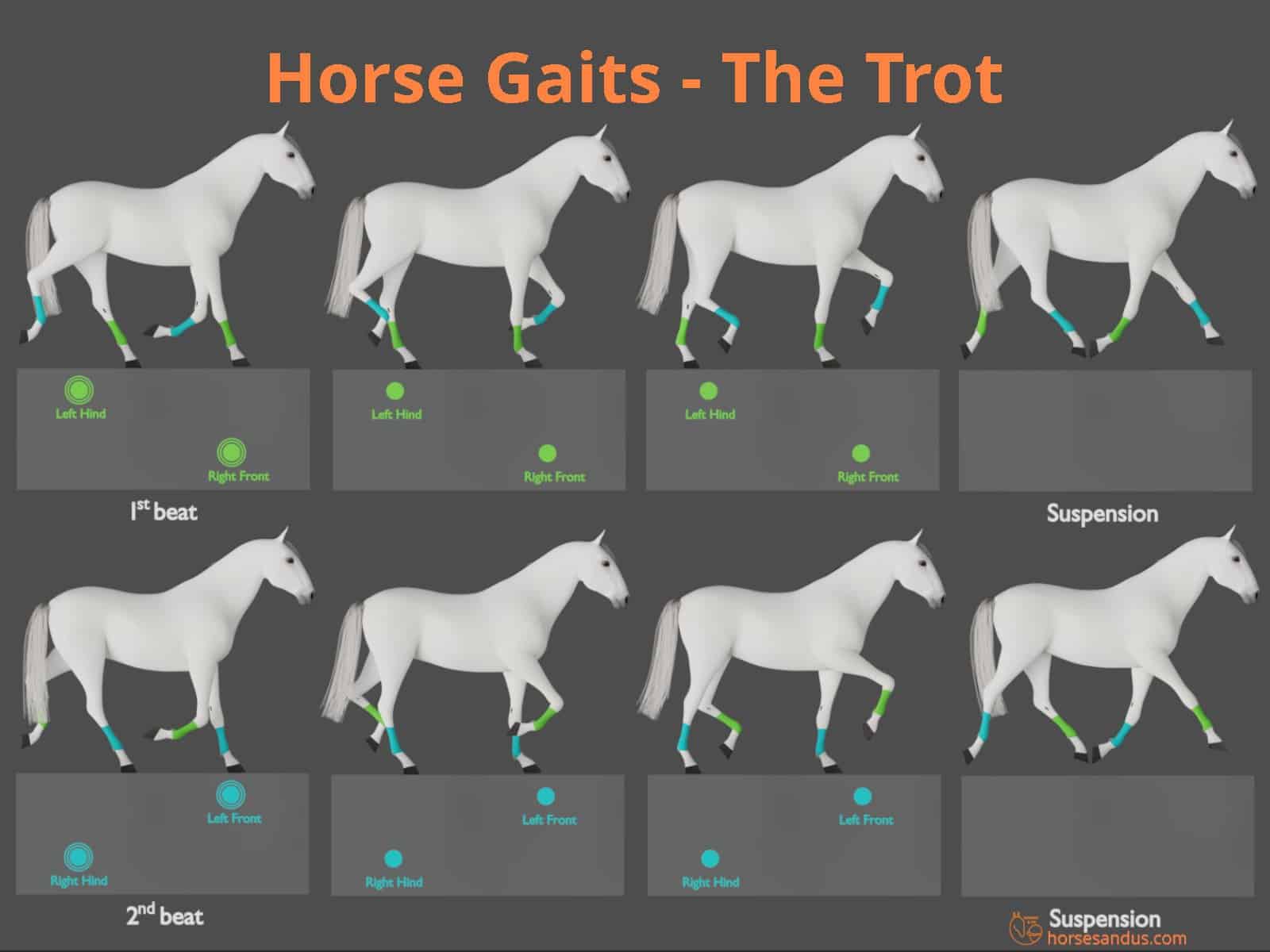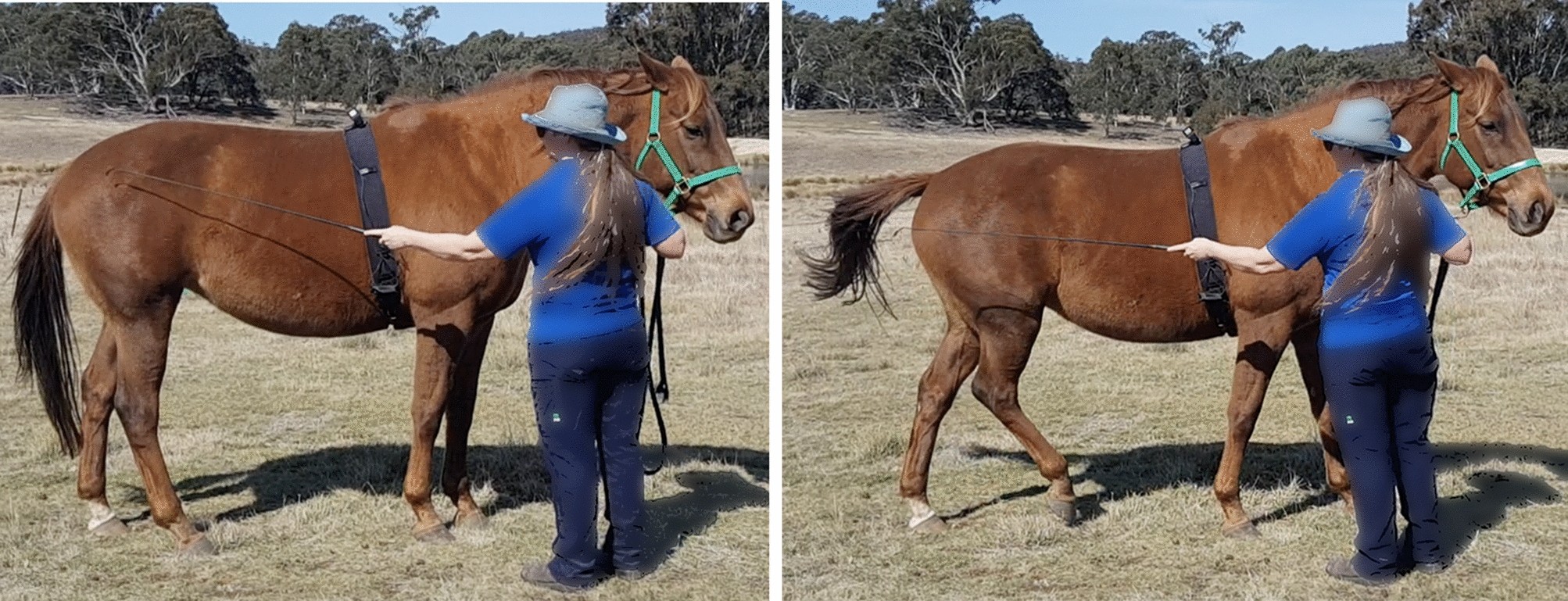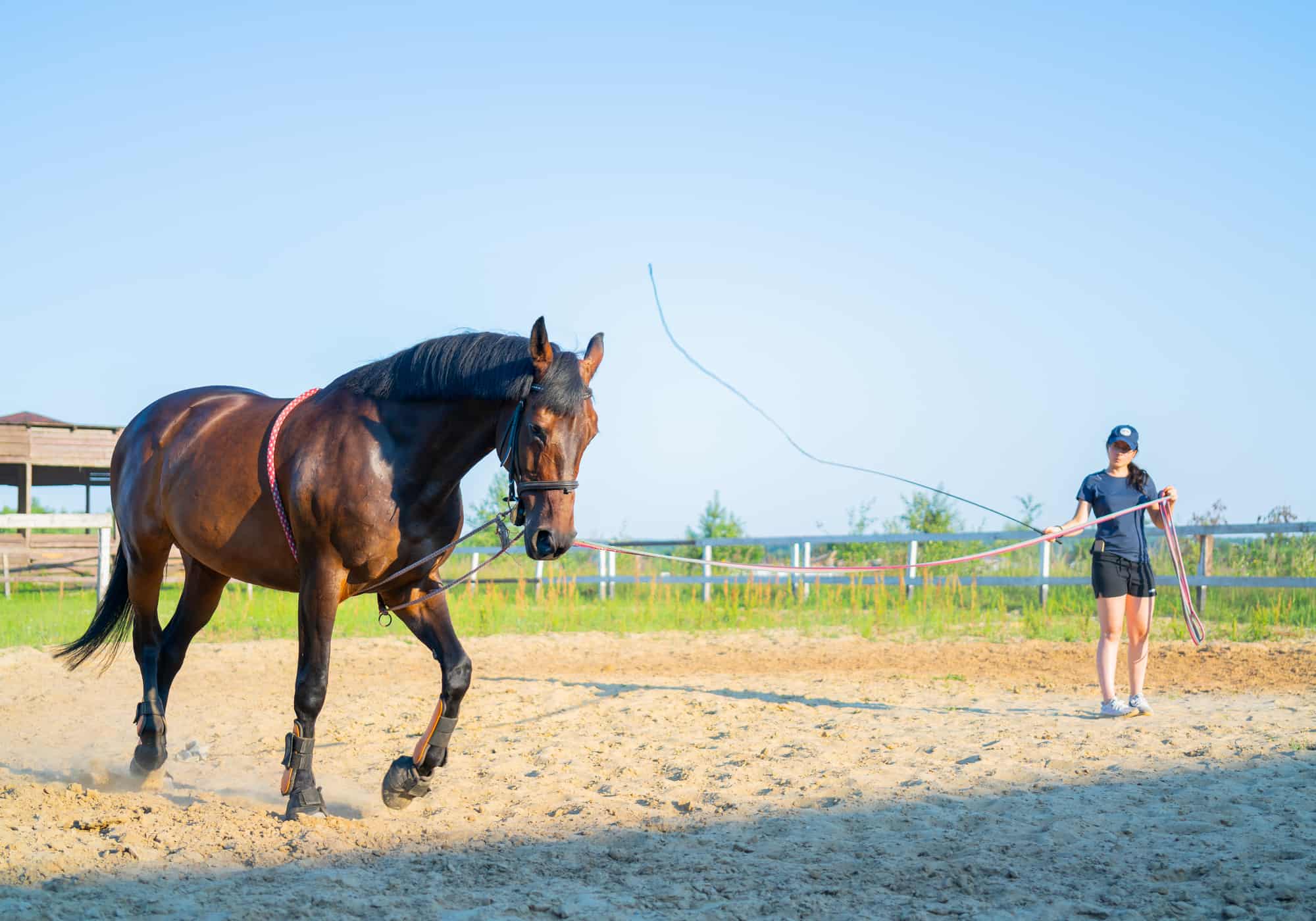Introduction to Horse Locomotion

Horses captivate us with their grace and power, especially when they run. Understanding the dynamics of equine movement not only fascinates equestrians and animal lovers but also reveals the intricate design behind these majestic creatures. As they move across open fields or race tracks, the beauty of their motion is a dance of coordinated muscle and bone.
The way horses run is a complex process involving various gaits. They naturally walk, trot, canter, and gallop, which are the horse’s natural gaits. Each gait has a distinctive pattern, with one or more hooves leaving the ground at a time, creating a sequence that ranges from a leisurely stroll to a full-speed charge:
- Walk – a four-beat gait where each hoof hits the ground separately.
- Trot – a two-beat gait where diagonally opposite legs move together.
- Canter – a three-beat gait that is faster than a trot but slower than a gallop.
- Gallop – the fastest four-beat gait where all four hooves are off the ground at one point.
Exploring Equine Movement Mechanics

The mechanics behind equine movement are not only striking to observe but also critical to comprehend for those interested in equine well-being and performance. While the grace of a horse in motion is readily visible, the underlying structure is a complex interplay of internal components. We’ll delve into the musculoskeletal system that underpins a horse’s mobility, casting light on the unseen aspects that facilitate their agility and strength.
Understanding the Equine Skeletal Structure
At the core of equine movement is the skeletal system, which serves as both the supportive framework and the facilitator of flexibility. Here’s an overview of its key parts:
- Vertebral Column: A series of vertebrae safeguards the spinal cord and provides points of attachment for ribs and muscles.
- Pelvic Girdle: The robust bones of the pelvis support the powerful muscles driving the hindlimbs.
- Appendicular Skeleton: This includes all limb bones, which are intricately arranged to afford a wide range of motion.
Articulations and Equine Mobility
The role of joints in equine movement cannot be understated as they enable smooth articulation between bones. We’ll focus on those joints critical to equine locomotion:
- Scapulohumeral Joint: This allows the forelimb to move forward and backward, crucial for extending stride length.
- Femorotibial Joint: Known as the stifle joint, it provides power and stability to the hindlimbs during motion.
- Metacarpophalangeal and Metatarsophalangeal Joints: Commonly referred to as fetlocks, these function like human fingers or toes, absorbing impacts and aiding in leverage.
The Driving Force: Equine Muscle Groups
The muscular system is the powerhouse behind a horse’s every move. It is categorized into three types, each with its role in locomotion:
- Voluntary Muscles: These muscles are responsible for voluntary actions and are essential for initiating movement.
- Heart Muscle: Critical for blood circulation, it ensures that muscles receive the necessary oxygen and nutrients during physical exertion.
- Visceral Muscles: Found within internal organs, these support locomotion indirectly by aiding in digestion and breathing.
The Significance of Connective Tissue in Equine Locomotion
Equine locomotion owes much to the connective tissues that bind muscles to bones and stabilize joints. These tissues are instrumental in the efficient transfer of force during movement:
- Tendons: These resilient bands of tissue are key to conveying muscular force to the skeleton, facilitating motion.
- Ligaments: They contribute to joint stability, aiding in the prevention of dislocations and injuries.
By examining the detailed anatomy of horse running, we gain a deeper understanding of their evolutionary journey as adept movers and competitive athletes. The interplay between the skeletal structure, joints, muscle groups, and connective tissues is crucial for their varied gait patterns and speeds. This knowledge is invaluable for those looking to ensure the well-being and peak performance of these noble animals.
Delving Deeper into Equine Gaits and Speed

The seamless integration of rhythm and balance in horses allows for the fluidity and speed that are hallmarks of their movement. When observing the broad spectrum of gaits expressed by various horse breeds, we witness the culmination of evolution fine-tuning their abilities to meet different environmental challenges.
Specialized Movements and Breed Adaptations
Horse breeds exhibit specialized gaits that highlight the impact of selective breeding on equine abilities. An example is the Icelandic Horse’s ‘amble’, which offers riders a smooth experience over rugged terrain. Additionally, the ‘pace’ of Standardbreds showcases the efficacy of breeding for speed in harness racing, further demonstrating the adaptability of horses to specific tasks.
- Amble – a steady, four-beat gait ideal for endurance riding.
- Pace – a swift, two-beat lateral gait that enhances speed in harness racing.
Agility and Stride Efficiency in Horse Speed
When considering a horse’s speed, we must look beyond mere velocity. Agility and stride efficiency significantly influence their pace. These attributes depend on a blend of genetic predispositions, tailored conditioning, and each horse’s unique physical build. The remarkable sprinting capabilities of Thoroughbreds contrast with the impressive endurance and sustained speed of Arabians, showcasing the diversity in equine performance.
Elements Affecting Equine Speed Potential
Various factors determine a horse’s running speed. The horse’s musculature, limb anatomy, and customized training all play pivotal roles. Proper nutrition and health management are equally critical in maintaining energy levels and facilitating recovery, thereby maximizing performance capabilities.
- Muscle Composition: The ratio of fast to slow-twitch muscle fibers influences both speed and stamina.
- Limb Length: Longer limbs may equate to a more extended stride, which could lead to increased speed.
- Training Regimens: Exercises tailored to strengthen specific muscle groups can optimize performance outcomes.
Adaptability and Efficiency Across Gaits
A closer examination of equine gaits reveals their adaptability and efficiency. From the energy-conserving walk to the vigorous gallop, each movement is tailored for specific scenarios, reflecting the evolutionary refinement of these animals. The walk, trot, canter, and gallop each serve distinct purposes, from conserving energy to achieving high speeds, demonstrating the versatility of horse locomotion.
| Gait | Description | Typical Speed |
|---|---|---|
| Walk | Steady four-beat gait for energy efficiency | 4-6 mph |
| Trot | Moderate-speed two-beat gait for covering distances | 8-12 mph |
| Canter | Smooth three-beat gait balancing speed and stamina | 10-17 mph |
| Gallop | Peak-speed four-beat gait with a phase of suspension | 30-40 mph |
In summary, the locomotion of horses is a complex and adaptive phenomenon that demonstrates their evolutionary progression to thrive in diverse settings. From the energy-efficient trot to the dynamic gallop, each gait fulfills a strategic role in the life and functionality of these magnificent animals. A thorough understanding of the factors that shape their movement provides a deeper appreciation for the sophisticated mechanics and physical prowess that allow horses to navigate their environment with such grace and power.
Insights into Equine Movement and Performance

The synchrony of muscle, bone, and tendon in the equine stride and gallop exemplifies nature’s sophisticated design. Horses exhibit a remarkable combination of muscle contraction, force transfer, and joint stabilization that enables them to perform with both strength and elegance.
Biomechanics of the Equine Stride
The biomechanics of the equine stride reflect a complex interaction of the horse’s physical attributes. From the initial engagement of the hindquarters to the energy transfer via tendons, and joint stabilization by ligaments, each component plays a crucial role in movement efficiency.
- Engagement: The hindquarters activate, with muscles contracting to initiate forward motion.
- Energy Transfer: Tendons act as springs, storing and releasing energy to propel the horse.
- Joint Stability: Ligaments maintain joint integrity, ensuring a balanced and fluid stride.
Enhancing Speed: The Gallop’s Phases
The transition to a gallop showcases a horse’s athletic capability, where the movement’s rhythm escalates to achieve higher velocity. This swiftest of gaits involves a launch phase, a moment of suspension, and a landing phase, each contributing to the horse’s impressive speed.
- Acceleration: The hind legs generate the initial thrust for increased speed.
- Graceful Suspension: During the aerial phase, all four hooves lift off, showcasing the horse’s agility.
- Controlled Landing: Upon landing, the forelegs manage the impact, readying for the next stride.
Adapting Stride Mechanics to Terrain
Horses exhibit remarkable adaptability in stride mechanics, altering their movement patterns to suit different terrains. This adaptability ensures effective navigation and optimal performance in a variety of landscapes, from the cushioned steps on a soft meadow to the more deliberate strides on a solid racetrack.
Gallop Sequence: A Study in Energy Management
The gallop sequence is a sophisticated display of energy management, where the power generated by the hindquarters is converted into forward motion during the aerial phase and managed during the landing. The horse’s body undergoes a seamless transfer of kinetic and potential energy throughout the gallop cycle, exemplifying the finesse of equine locomotion.
| Phase | Action | Energy Management |
|---|---|---|
| Preparation | Engages the hindquarters for takeoff | Accumulates potential energy |
| Flight | Advances the body in suspension | Transforms energy into kinetic form |
| Recovery | Forelegs manage the impact of return | Energy is regulated, preparing for continuation |
Influences on Stride Characteristics
The characteristics of a horse’s stride, such as its length and frequency, are affected by multiple factors, including limb structure, muscle strength, and joint range of motion. These elements interact to shape the horse’s gait and efficiency, with breeds like Thoroughbreds and Arabians displaying variations in stride suited to their respective racing and endurance capabilities.
- Limb Structure: The anatomical design of the legs influences stride mechanics.
- Muscle Strength: Robust musculature contributes to a more potent and extended stride.
- Range of Joint Motion: Enhanced joint mobility can improve stride fluidity.
The comprehensive analysis of horse stride and gallop unravels the complex interplay between anatomy and performance, shedding light on the evolutionary advancements of these equine athletes. By appreciating the intricate details of their locomotion, we deepen our understanding of the horse’s physical excellence and adaptability.
Approaches to Enhancing Equine Athleticism

Preparing horses for the rigors of racing encompasses an in-depth appreciation of their physical and psychological needs. The training process is multifaceted, aiming to refine a horse’s innate capabilities to meet the high demands of competitive racing. Comprehensive conditioning regimens, mental stimulation, and dietary strategies are employed to cultivate an equine athlete that excels on the racetrack.
Refining Racing Strength and Stamina
Key to a racehorse’s success is its ability to sprint with vigor. Training regimens are designed to bolster this explosive power alongside endurance:
- High-Intensity Interval Training: Alternating high-speed gallops with recovery periods to enhance muscle performance.
- Gradient Workouts: Training on various terrains, particularly inclines, to fortify the hindquarters and boost thrust.
Comprehensive Exercise Routines
A well-rounded exercise program is crucial for developing different aspects of a horse’s physicality:
- Endurance Workouts: Extended, moderate exertion to improve the cardiovascular system’s efficiency.
- Flexibility and Agility Drills: Dynamic exercises that promote joint health and prevent injuries while maintaining the horse’s agility.
Nutrition and Recovery in Equine Training
Equine athletes require a carefully curated diet to fuel their performance and recovery:
- Customized Feeding Plans: Diets formulated to deliver a mix of energy sources, including carbohydrates and fats.
- Effective Hydration Strategies: Adequate water intake is essential for metabolic functions and cooling the body post-exercise.
- Targeted Supplementation: Strategic use of vitamins and minerals to enhance overall well-being and performance.
Advanced Racing Skills for Competitive Edge
Training extends beyond speed, focusing on skills essential for racing success:
Mastering the Starting Gate
A strong start is critical in racing, requiring specific preparation:
- Desensitization to the Gate: Acclimating the horse to the starting gate to reduce stress and ensure a rapid departure.
- Start Response Training: Perfecting the horse’s reflex to the start signal for immediate thrust out of the gate.
Strategic Race Execution
Intelligent race conduct is key to victory:
- Racecraft Training: Educating the horse on optimal race positioning and competitor awareness.
- Energy Pacing: Teaching the horse how to effectively distribute its energy throughout the race for a strong finish.
Enhancing Jockey-Horse Collaboration
A harmonious relationship between the jockey and horse is foundational:
- Reactivity Training: Ensuring the horse promptly reacts to the jockey’s instructions during the race.
- Building Trust and Understanding: Developing a dependable relationship so the horse feels confident following the jockey’s lead.
Integrating these comprehensive training strategies is critical for developing a versatile racehorse. This blend of horsemanship and scientific athletic training fosters the horse’s mental and physical capabilities, setting the stage for outstanding performances in competitive horse racing.
Optimizing Long-Distance Performance in Running Horses
Optimizing long-distance performance in running horses involves enhancing their natural ability to sustain prolonged physical activity. This includes improving their physical conditioning, ensuring their psychological well-being, and providing them with the necessary recovery time. While some breeds naturally excel at endurance, such as Arabians, all running horses can benefit from targeted training, proper nutrition, and health management to maximize their long-distance potential.
Maximizing Genetic and Physical Endurance Traits
Endurance is heavily influenced by a horse’s genetics and physical attributes. Key factors include:
- Breed Characteristics: Certain breeds, such as Arabians, are renowned for their exceptional stamina and durability over long distances.
- Cardiorespiratory Capacity: An efficient heart and lung system is crucial for delivering oxygen to the muscles during extended periods of exercise.
- Cellular Energy Production: The capacity of muscle cells to generate energy, particularly through the mitochondria, is vital for endurance.
Dynamic Training Methods for Enhanced Stamina
Developing a horse’s stamina requires innovative training techniques:
- Diverse Exercise Regimens: A varied training routine, which may include swimming or hill work, helps improve a horse’s overall fitness and prevents training fatigue.
- Progressive Overload: Gradually increasing the intensity and volume of workouts helps to build endurance, while also incorporating rest periods to prevent overtraining.
- Adaptable Training Plans: Continuously evaluating and adjusting the horse’s training regimen ensures that the horse is not pushed beyond its limits.
Nutritional Strategies for Sustained Energy
Proper nutrition is fundamental for endurance:
- Caloric Intake: A diet that meets the energy demands of a horse’s training schedule is essential for maintaining stamina.
- Hydration and Electrolytes: Proper hydration and electrolyte replenishment are necessary to prevent fatigue and other health complications.
- High-Quality Forage: A diet with sufficient forage supports gastrointestinal health, which is critical for energy conservation and endurance.
Supporting the Horse’s Mental Fortitude
Mental health is as significant as physical fitness in a horse’s long-distance capabilities:
- Minimizing Stress: Techniques that alleviate stress contribute to the horse’s mental well-being and can improve endurance.
- Constructive Training Atmosphere: A positive and encouraging training environment fosters a horse’s willingness to perform.
- Cognitive Engagement: Providing diverse and engaging activities helps maintain the horse’s mental sharpness, which can enhance endurance.
Recovery and Health Management for Peak Performance
Consistent health care and recovery are crucial for maintaining endurance:
- Veterinary Oversight: Regular check-ups help identify and treat any health issues early on.
- Recovery Techniques: Incorporating massages, stretches, and other therapeutic methods aids muscle and joint recovery.
- Rest Periods: Allowing adequate time for mental and physical rest is as important as active training in a horse’s regimen.
Fostering endurance in running horses is a comprehensive process that requires attention to their physical and mental needs. By understanding and addressing the multiple aspects that contribute to endurance, trainers can develop specialized programs that enhance a horse’s innate capacity for long-distance running, preparing them for the rigors of endurance competitions.
Curious about the various aspects of horse behavior and physiology? While we delve into the dynamics of how horses run here, you might also be intrigued by their capabilities in water, the mechanics of their hooves, and even their reproductive behaviors. Enhance your understanding by exploring our informative pieces on how horses swim, how horse hooves work, and the processes behind how horses reproduce. Each topic offers a fascinating glimpse into the complex and remarkable nature of these noble creatures.
Conclusion
In closing, the phenomenon of horse locomotion combines the elegance of natural design with the profound capabilities of these animals. From the fundamental horse running mechanics to the complexities of equine gait analysis, each aspect contributes to the impressive sight of a horse in full stride. As we delve into the anatomy of horse running, it becomes clear that these creatures are built for movement, whether it’s the steady pace of a trot or the exhilarating rush of a gallop.
Our understanding of how horses move has evolved, allowing us to better appreciate, train, and care for these extraordinary animals. With advancements in equine gait analysis, we can now fine-tune training horses to run, employing horse racing techniques that optimize their natural abilities. The pursuit of endurance in running horses continues to drive research and innovation, aiming to sustain and enhance their remarkable performances. Ultimately, horses not only run; they inspire, amaze, and remind us of the sheer joy of motion.



